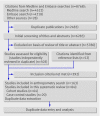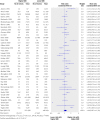Overweight and obesity in mothers and risk of preterm birth and low birth weight infants: systematic review and meta-analyses
- PMID: 20647282
- PMCID: PMC2907482
- DOI: 10.1136/bmj.c3428
Overweight and obesity in mothers and risk of preterm birth and low birth weight infants: systematic review and meta-analyses
Abstract
Objective: To determine the relation between overweight and obesity in mothers and preterm birth and low birth weight in singleton pregnancies in developed and developing countries.
Design: Systematic review and meta-analyses.
Data sources: Medline and Embase from their inceptions, and reference lists of identified articles.
Study selection: Studies including a reference group of women with normal body mass index that assessed the effect of overweight and obesity on two primary outcomes: preterm birth (before 37 weeks) and low birth weight (<2500 g).
Data extraction: Two assessors independently reviewed titles, abstracts, and full articles, extracted data using a piloted data collection form, and assessed quality.
Data synthesis: 84 studies (64 cohort and 20 case-control) were included, totalling 1 095 834 women. Although the overall risk of preterm birth was similar in overweight and obese women and women of normal weight, the risk of induced preterm birth was increased in overweight and obese women (relative risk 1.30, 95% confidence interval 1.23 to 1.37). Although overall the risk of having an infant of low birth weight was decreased in overweight and obese women (0.84, 0.75 to 0.95), the decrease was greater in developing countries than in developed countries (0.58, 0.47 to 0.71 v 0.90, 0.79 to 1.01). After accounting for publication bias, the apparent protective effect of overweight and obesity on low birth weight disappeared with the addition of imputed "missing" studies (0.95, 0.85 to 1.07), whereas the risk of preterm birth appeared significantly higher in overweight and obese women (1.24, 1.13 to 1.37).
Conclusions: Overweight and obese women have increased risks of preterm birth and induced preterm birth and, after accounting for publication bias, appeared to have increased risks of preterm birth overall. The beneficial effects of maternal overweight and obesity on low birth weight were greater in developing countries and disappeared after accounting for publication bias.
Conflict of interest statement
Competing interests: All authors have completed the unified competing interest form and declare that: (1) this work was supported by a Canadian Institute of Health Research (CIHR) operating grant (No KRS 86242), that SDMcD is supported by a CIHR new investigator award, that ZH was supported by a state scholarship fund by the China Scholarship Council, and that JB is supported by a CIHR grant (No 84392); (2) SDMcD, ZH, SM, and JB have no relationships with any companies that might have an interest in the submitted work in the previous 3 years; (3) their spouses, partners, or children have no financial relationships that may be relevant to the submitted work; and (4) SDMcD, ZH, SM, and JB have no non-financial interests that may be relevant to the submitted work. CIHR and the China Scholarship Council had no role in analyses, writing of the report, interpretation of data or the decision to submit the manuscript.
Figures




References
-
- Heslehurst N, Ells LJ, Simpson H, Batterham A, Wilkinson J, Summerbell CD. Trends in maternal obesity incidence rates, demographic predictors, and health inequalities in 36,821 women over a 15-year period. BJOG 2007;114:187-94. - PubMed
-
- Savitz DA, Dole N, Herring AH, Kaczor D, Murphy J, Siega-Riz AM, et al. Should spontaneous and medically indicated preterm births be separated for studying aetiology? Paediatr Perinat Epidemiol 2005;19:97-105. - PubMed
-
- Roman H, Goffinet F, Hulsey TF, Newman R, Robillard PY, Hulsey TC. Maternal body mass index at delivery and risk of caesarean due to dystocia in low risk pregnancies. Acta Obstet Gynecol Scand 2008;87:163-70. - PubMed
-
- Salihu HM, Lynch O, Alio AP, Liu J. Obesity subtypes and risk of spontaneous versus medically indicated preterm births in singletons and twins. Am J Epidemiol 2008;168:13-20. - PubMed
-
- Sahu MT, Agarwal A, Das V, Pandey A. Impact of maternal body mass index on obstetric outcome. J Obstet Gynaecol Res 2007;33:655-9. - PubMed
Publication types
MeSH terms
Grants and funding
LinkOut - more resources
Full Text Sources
